Telemedicine in Australia: Overview, Practices, and Recommendations
VerifiedAdded on 2023/01/10
|10
|3228
|1
Report
AI Summary
This report provides a comprehensive overview of telemedicine practices in Australia. It begins with an introduction to telemedicine, defining its role in providing remote healthcare services. The main body of the report summarizes and overviews various telemedicine practices in Australia, including store and forward, remote monitoring, and real-time interactive services. It then delves into the roles of the Royal Australian College of General Practitioners (RACGP) and the Australian College of Rural and Remote Medicine (ACRRM), outlining their guidelines and training programs for telemedicine. Furthermore, it addresses the involvement of state departments of health in ensuring proper telemedicine facilities. The report concludes with recommendations for improving telemedicine practices and references supporting literature.
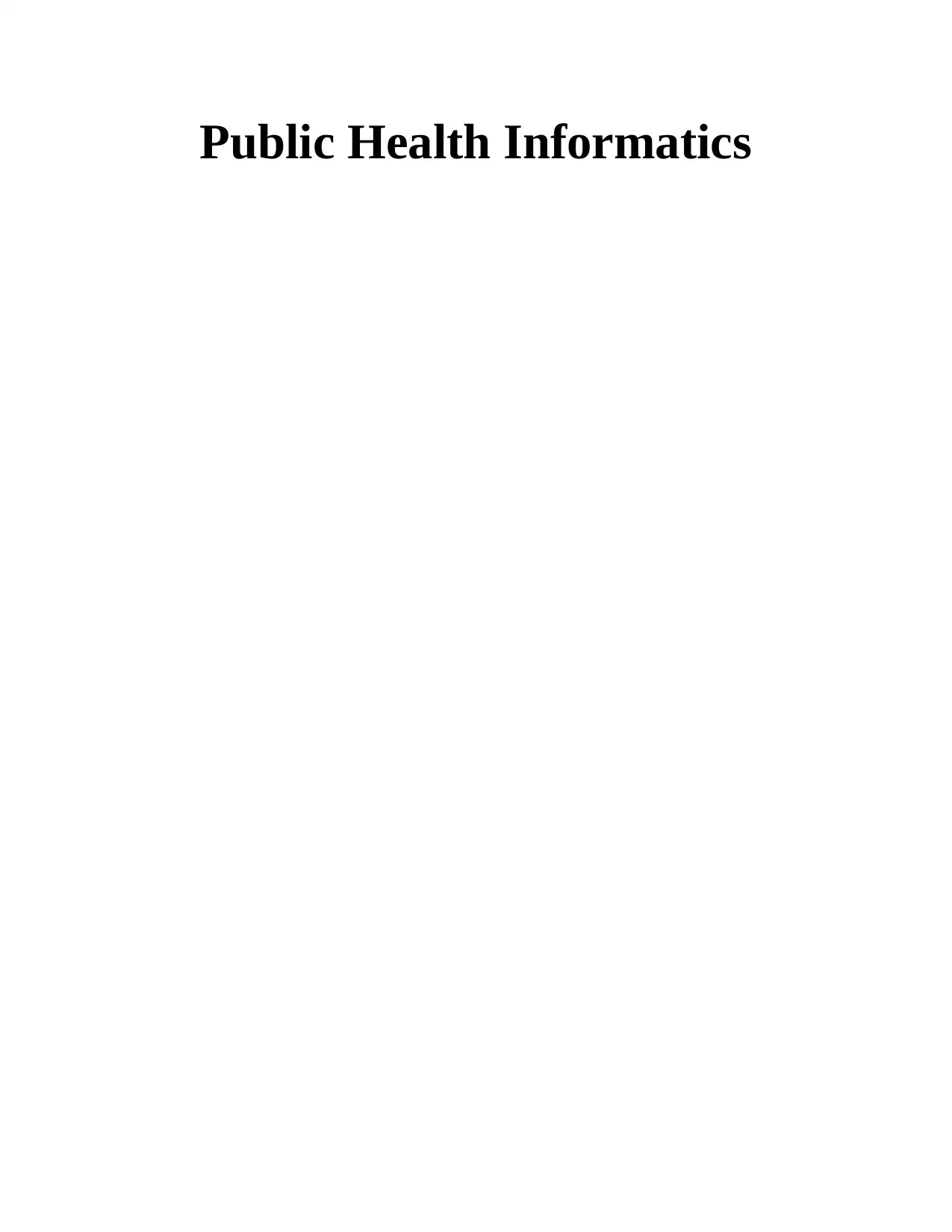
Public Health Informatics
Paraphrase This Document
Need a fresh take? Get an instant paraphrase of this document with our AI Paraphraser
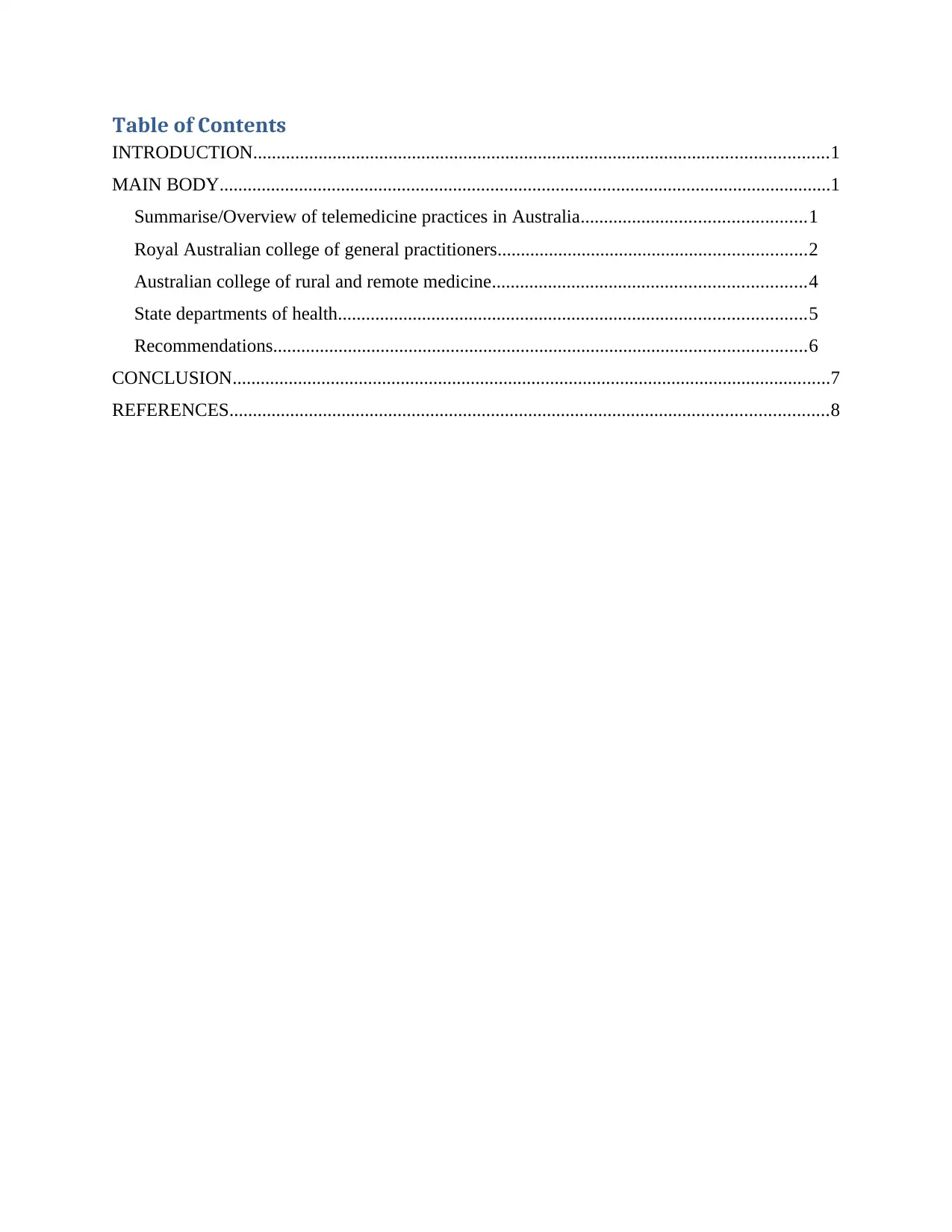
Table of Contents
INTRODUCTION...........................................................................................................................1
MAIN BODY...................................................................................................................................1
Summarise/Overview of telemedicine practices in Australia................................................1
Royal Australian college of general practitioners..................................................................2
Australian college of rural and remote medicine...................................................................4
State departments of health....................................................................................................5
Recommendations..................................................................................................................6
CONCLUSION................................................................................................................................7
REFERENCES................................................................................................................................8
INTRODUCTION...........................................................................................................................1
MAIN BODY...................................................................................................................................1
Summarise/Overview of telemedicine practices in Australia................................................1
Royal Australian college of general practitioners..................................................................2
Australian college of rural and remote medicine...................................................................4
State departments of health....................................................................................................5
Recommendations..................................................................................................................6
CONCLUSION................................................................................................................................7
REFERENCES................................................................................................................................8

INTRODUCTION
Telemedicine refers to a practice of providing care services for patient remotely when physician
and client are not present with each other. It includes the act of care practitioners of evaluating,
diagnosing and treating patients at a distance with the help of using telecommunications (Hyland,
Raymond and Chong, 2018). The telemedicine is all about to have support of technology in order
to facilitate remotely care that is known as telehealth. In context of this project, it is based on the
concept of telemedicine in Australia for providing effective care for welfare of people living at a
distance from healthcare centres or hospitals. It includes the use of telemedicine within the
country to increase effectiveness of entire healthcare system. This assignment will focus on
telemedicine practices in Australia and other departments of health with proper overview. It will
also include the respective recommendations about telemedicine and government practices.
MAIN BODY
Summarise/Overview of telemedicine practices in Australia
Telemedicine practices can be defined as an act of providing care to those people who were
living far away from healthcare centres or hospitals. It includes the criterion of using advanced
technology in order to assist patients to gain proper medications for solving their specific
problem of health. Basically, it is observed that telemedicine can be considered as criterion of
using technology including computers, videos or phones by a medical practitioner in terms of
diagnosing as well as treating particular health problem of clients in a remote location (Estai,
Kruger and Tennant, 2016). It involves the utilisation of telemedicine for providing help to those
people who does not have any hospital in the locality and needs to travel more to gain healthcare
services. It is favourable to assist such people by the support of technology to sort out their
respective medical problems for making them disease free. In context of Australia, there are
number of telemedicine practices are used to fulfil actual healthcare needs of citizens in which
some of them are explained here.
Store and forward – This kind of telemedicine can be considered as an aspect of developing
requirement for care professionals to meet in person with a patient. It includes the criterion of
sending data as medical bio signals or images to specific specialist as per actual needs to provide
desired treatment effectively. However, this telemedicine practice is common in dermatology,
radiology and pathology in Australia because it is an effective practices which is helpful to save
1
Telemedicine refers to a practice of providing care services for patient remotely when physician
and client are not present with each other. It includes the act of care practitioners of evaluating,
diagnosing and treating patients at a distance with the help of using telecommunications (Hyland,
Raymond and Chong, 2018). The telemedicine is all about to have support of technology in order
to facilitate remotely care that is known as telehealth. In context of this project, it is based on the
concept of telemedicine in Australia for providing effective care for welfare of people living at a
distance from healthcare centres or hospitals. It includes the use of telemedicine within the
country to increase effectiveness of entire healthcare system. This assignment will focus on
telemedicine practices in Australia and other departments of health with proper overview. It will
also include the respective recommendations about telemedicine and government practices.
MAIN BODY
Summarise/Overview of telemedicine practices in Australia
Telemedicine practices can be defined as an act of providing care to those people who were
living far away from healthcare centres or hospitals. It includes the criterion of using advanced
technology in order to assist patients to gain proper medications for solving their specific
problem of health. Basically, it is observed that telemedicine can be considered as criterion of
using technology including computers, videos or phones by a medical practitioner in terms of
diagnosing as well as treating particular health problem of clients in a remote location (Estai,
Kruger and Tennant, 2016). It involves the utilisation of telemedicine for providing help to those
people who does not have any hospital in the locality and needs to travel more to gain healthcare
services. It is favourable to assist such people by the support of technology to sort out their
respective medical problems for making them disease free. In context of Australia, there are
number of telemedicine practices are used to fulfil actual healthcare needs of citizens in which
some of them are explained here.
Store and forward – This kind of telemedicine can be considered as an aspect of developing
requirement for care professionals to meet in person with a patient. It includes the criterion of
sending data as medical bio signals or images to specific specialist as per actual needs to provide
desired treatment effectively. However, this telemedicine practice is common in dermatology,
radiology and pathology in Australia because it is an effective practices which is helpful to save
1
⊘ This is a preview!⊘
Do you want full access?
Subscribe today to unlock all pages.

Trusted by 1+ million students worldwide
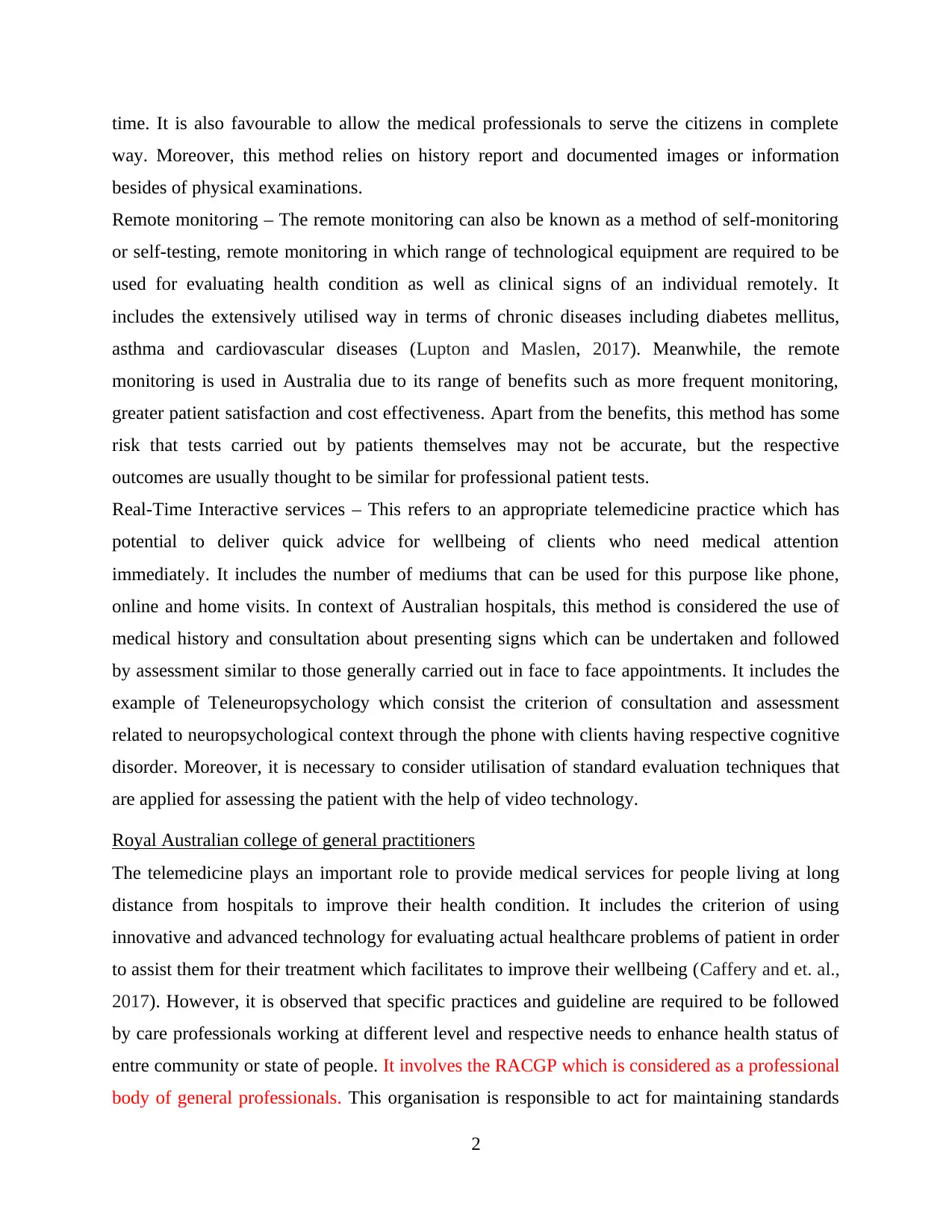
time. It is also favourable to allow the medical professionals to serve the citizens in complete
way. Moreover, this method relies on history report and documented images or information
besides of physical examinations.
Remote monitoring – The remote monitoring can also be known as a method of self-monitoring
or self-testing, remote monitoring in which range of technological equipment are required to be
used for evaluating health condition as well as clinical signs of an individual remotely. It
includes the extensively utilised way in terms of chronic diseases including diabetes mellitus,
asthma and cardiovascular diseases (Lupton and Maslen, 2017). Meanwhile, the remote
monitoring is used in Australia due to its range of benefits such as more frequent monitoring,
greater patient satisfaction and cost effectiveness. Apart from the benefits, this method has some
risk that tests carried out by patients themselves may not be accurate, but the respective
outcomes are usually thought to be similar for professional patient tests.
Real-Time Interactive services – This refers to an appropriate telemedicine practice which has
potential to deliver quick advice for wellbeing of clients who need medical attention
immediately. It includes the number of mediums that can be used for this purpose like phone,
online and home visits. In context of Australian hospitals, this method is considered the use of
medical history and consultation about presenting signs which can be undertaken and followed
by assessment similar to those generally carried out in face to face appointments. It includes the
example of Teleneuropsychology which consist the criterion of consultation and assessment
related to neuropsychological context through the phone with clients having respective cognitive
disorder. Moreover, it is necessary to consider utilisation of standard evaluation techniques that
are applied for assessing the patient with the help of video technology.
Royal Australian college of general practitioners
The telemedicine plays an important role to provide medical services for people living at long
distance from hospitals to improve their health condition. It includes the criterion of using
innovative and advanced technology for evaluating actual healthcare problems of patient in order
to assist them for their treatment which facilitates to improve their wellbeing (Caffery and et. al.,
2017). However, it is observed that specific practices and guideline are required to be followed
by care professionals working at different level and respective needs to enhance health status of
entre community or state of people. It involves the RACGP which is considered as a professional
body of general professionals. This organisation is responsible to act for maintaining standards
2
way. Moreover, this method relies on history report and documented images or information
besides of physical examinations.
Remote monitoring – The remote monitoring can also be known as a method of self-monitoring
or self-testing, remote monitoring in which range of technological equipment are required to be
used for evaluating health condition as well as clinical signs of an individual remotely. It
includes the extensively utilised way in terms of chronic diseases including diabetes mellitus,
asthma and cardiovascular diseases (Lupton and Maslen, 2017). Meanwhile, the remote
monitoring is used in Australia due to its range of benefits such as more frequent monitoring,
greater patient satisfaction and cost effectiveness. Apart from the benefits, this method has some
risk that tests carried out by patients themselves may not be accurate, but the respective
outcomes are usually thought to be similar for professional patient tests.
Real-Time Interactive services – This refers to an appropriate telemedicine practice which has
potential to deliver quick advice for wellbeing of clients who need medical attention
immediately. It includes the number of mediums that can be used for this purpose like phone,
online and home visits. In context of Australian hospitals, this method is considered the use of
medical history and consultation about presenting signs which can be undertaken and followed
by assessment similar to those generally carried out in face to face appointments. It includes the
example of Teleneuropsychology which consist the criterion of consultation and assessment
related to neuropsychological context through the phone with clients having respective cognitive
disorder. Moreover, it is necessary to consider utilisation of standard evaluation techniques that
are applied for assessing the patient with the help of video technology.
Royal Australian college of general practitioners
The telemedicine plays an important role to provide medical services for people living at long
distance from hospitals to improve their health condition. It includes the criterion of using
innovative and advanced technology for evaluating actual healthcare problems of patient in order
to assist them for their treatment which facilitates to improve their wellbeing (Caffery and et. al.,
2017). However, it is observed that specific practices and guideline are required to be followed
by care professionals working at different level and respective needs to enhance health status of
entre community or state of people. It involves the RACGP which is considered as a professional
body of general professionals. This organisation is responsible to act for maintaining standards
2
Paraphrase This Document
Need a fresh take? Get an instant paraphrase of this document with our AI Paraphraser

for quality clinical practice, education, training and research in Australian general practice. It
includes various standards of performance and guidelines which are required to be followed
healthcare organisations for providing healthcare services including telemedicine facilities for
welfare of people. However, it is very important for general practitioners and staff to follow set
standards and guidelines which are suitable o deliver accurate care facilities to make patients
disease free (O'Gorman, Hogenbirk and Warry, 2016). It will facilitate to enhance the accuracy
and quality of telemedicine services for enhancing health status of entire population. The Royal
Australian College of general practitioners has some of guidelines to deliver telemedicine care
facilities effectively which are given below.
Initially, it is required that a video consultations should be planned and coordinated approach in
general practice for its successful implementation. Secondly, it is necessary to carry out video
consultation in general and familiar consulting atmosphere which consist systems appropriate for
clinical purpose along with securing privacy of the consultation including security,
confidentiality & privacy of health condition of client for successful conduct. Thirdly, it is
essential to have an adequate connectivity of internet for supporting audio and video quality for
clinical reason otherwise the information collected about patient remain in accurate or
insufficient for providing care services in correct manner. Basically, it consist the criterion of
providing efficient training and learning to general practices as well as other clinical staff to
perform with coordination for integrating video consultation in terms of work flow (Mohsen and
et. al., 2019). It is required to consider best practice principles for making proper use of internet
as well as communication privacy with the help of following respective standards for general
practices and RACGP computer & information security standards properly. It is necessary for
general practitioners to remain ware of linked limitations and risks at the time of considering
peer to peer or freely available technologies. Meanwhile, the Royal Australian College of general
practitioners is responsible for providing an important recommendation for general practitioners
that they must adopt a default position of not recording video consultations. It is significant use
the guideline that health information collected and captured at the time of course of video
consultations which should not be stored outside the Australia.
In addition to this, it is necessary for practitioners, clinicians and physician consultation
participating in video consultation are required to have favourable professionals indemnity
insurance as provided by a medical defence organisation, employer or commercial insurer.
3
includes various standards of performance and guidelines which are required to be followed
healthcare organisations for providing healthcare services including telemedicine facilities for
welfare of people. However, it is very important for general practitioners and staff to follow set
standards and guidelines which are suitable o deliver accurate care facilities to make patients
disease free (O'Gorman, Hogenbirk and Warry, 2016). It will facilitate to enhance the accuracy
and quality of telemedicine services for enhancing health status of entire population. The Royal
Australian College of general practitioners has some of guidelines to deliver telemedicine care
facilities effectively which are given below.
Initially, it is required that a video consultations should be planned and coordinated approach in
general practice for its successful implementation. Secondly, it is necessary to carry out video
consultation in general and familiar consulting atmosphere which consist systems appropriate for
clinical purpose along with securing privacy of the consultation including security,
confidentiality & privacy of health condition of client for successful conduct. Thirdly, it is
essential to have an adequate connectivity of internet for supporting audio and video quality for
clinical reason otherwise the information collected about patient remain in accurate or
insufficient for providing care services in correct manner. Basically, it consist the criterion of
providing efficient training and learning to general practices as well as other clinical staff to
perform with coordination for integrating video consultation in terms of work flow (Mohsen and
et. al., 2019). It is required to consider best practice principles for making proper use of internet
as well as communication privacy with the help of following respective standards for general
practices and RACGP computer & information security standards properly. It is necessary for
general practitioners to remain ware of linked limitations and risks at the time of considering
peer to peer or freely available technologies. Meanwhile, the Royal Australian College of general
practitioners is responsible for providing an important recommendation for general practitioners
that they must adopt a default position of not recording video consultations. It is significant use
the guideline that health information collected and captured at the time of course of video
consultations which should not be stored outside the Australia.
In addition to this, it is necessary for practitioners, clinicians and physician consultation
participating in video consultation are required to have favourable professionals indemnity
insurance as provided by a medical defence organisation, employer or commercial insurer.
3
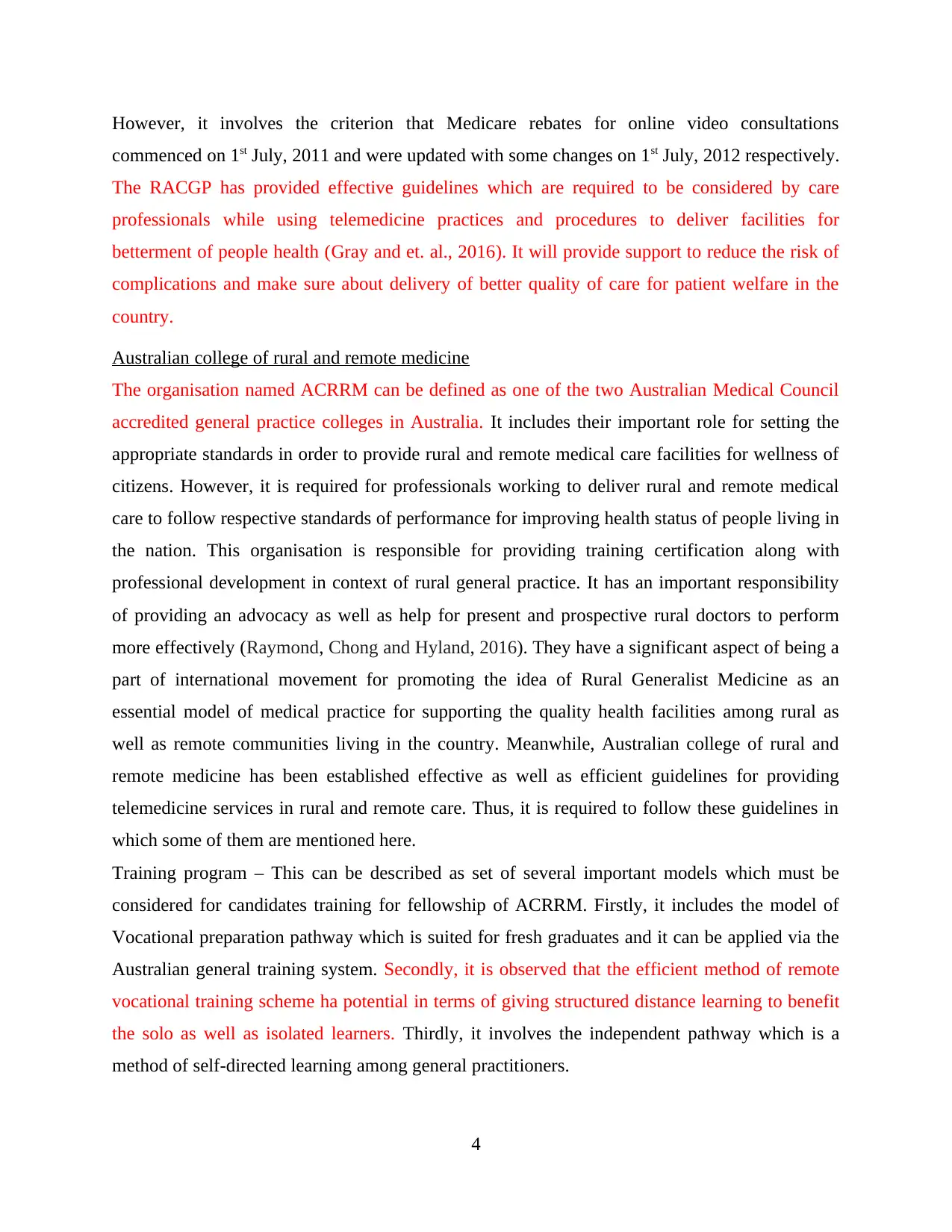
However, it involves the criterion that Medicare rebates for online video consultations
commenced on 1st July, 2011 and were updated with some changes on 1st July, 2012 respectively.
The RACGP has provided effective guidelines which are required to be considered by care
professionals while using telemedicine practices and procedures to deliver facilities for
betterment of people health (Gray and et. al., 2016). It will provide support to reduce the risk of
complications and make sure about delivery of better quality of care for patient welfare in the
country.
Australian college of rural and remote medicine
The organisation named ACRRM can be defined as one of the two Australian Medical Council
accredited general practice colleges in Australia. It includes their important role for setting the
appropriate standards in order to provide rural and remote medical care facilities for wellness of
citizens. However, it is required for professionals working to deliver rural and remote medical
care to follow respective standards of performance for improving health status of people living in
the nation. This organisation is responsible for providing training certification along with
professional development in context of rural general practice. It has an important responsibility
of providing an advocacy as well as help for present and prospective rural doctors to perform
more effectively (Raymond, Chong and Hyland, 2016). They have a significant aspect of being a
part of international movement for promoting the idea of Rural Generalist Medicine as an
essential model of medical practice for supporting the quality health facilities among rural as
well as remote communities living in the country. Meanwhile, Australian college of rural and
remote medicine has been established effective as well as efficient guidelines for providing
telemedicine services in rural and remote care. Thus, it is required to follow these guidelines in
which some of them are mentioned here.
Training program – This can be described as set of several important models which must be
considered for candidates training for fellowship of ACRRM. Firstly, it includes the model of
Vocational preparation pathway which is suited for fresh graduates and it can be applied via the
Australian general training system. Secondly, it is observed that the efficient method of remote
vocational training scheme ha potential in terms of giving structured distance learning to benefit
the solo as well as isolated learners. Thirdly, it involves the independent pathway which is a
method of self-directed learning among general practitioners.
4
commenced on 1st July, 2011 and were updated with some changes on 1st July, 2012 respectively.
The RACGP has provided effective guidelines which are required to be considered by care
professionals while using telemedicine practices and procedures to deliver facilities for
betterment of people health (Gray and et. al., 2016). It will provide support to reduce the risk of
complications and make sure about delivery of better quality of care for patient welfare in the
country.
Australian college of rural and remote medicine
The organisation named ACRRM can be defined as one of the two Australian Medical Council
accredited general practice colleges in Australia. It includes their important role for setting the
appropriate standards in order to provide rural and remote medical care facilities for wellness of
citizens. However, it is required for professionals working to deliver rural and remote medical
care to follow respective standards of performance for improving health status of people living in
the nation. This organisation is responsible for providing training certification along with
professional development in context of rural general practice. It has an important responsibility
of providing an advocacy as well as help for present and prospective rural doctors to perform
more effectively (Raymond, Chong and Hyland, 2016). They have a significant aspect of being a
part of international movement for promoting the idea of Rural Generalist Medicine as an
essential model of medical practice for supporting the quality health facilities among rural as
well as remote communities living in the country. Meanwhile, Australian college of rural and
remote medicine has been established effective as well as efficient guidelines for providing
telemedicine services in rural and remote care. Thus, it is required to follow these guidelines in
which some of them are mentioned here.
Training program – This can be described as set of several important models which must be
considered for candidates training for fellowship of ACRRM. Firstly, it includes the model of
Vocational preparation pathway which is suited for fresh graduates and it can be applied via the
Australian general training system. Secondly, it is observed that the efficient method of remote
vocational training scheme ha potential in terms of giving structured distance learning to benefit
the solo as well as isolated learners. Thirdly, it involves the independent pathway which is a
method of self-directed learning among general practitioners.
4
⊘ This is a preview!⊘
Do you want full access?
Subscribe today to unlock all pages.

Trusted by 1+ million students worldwide
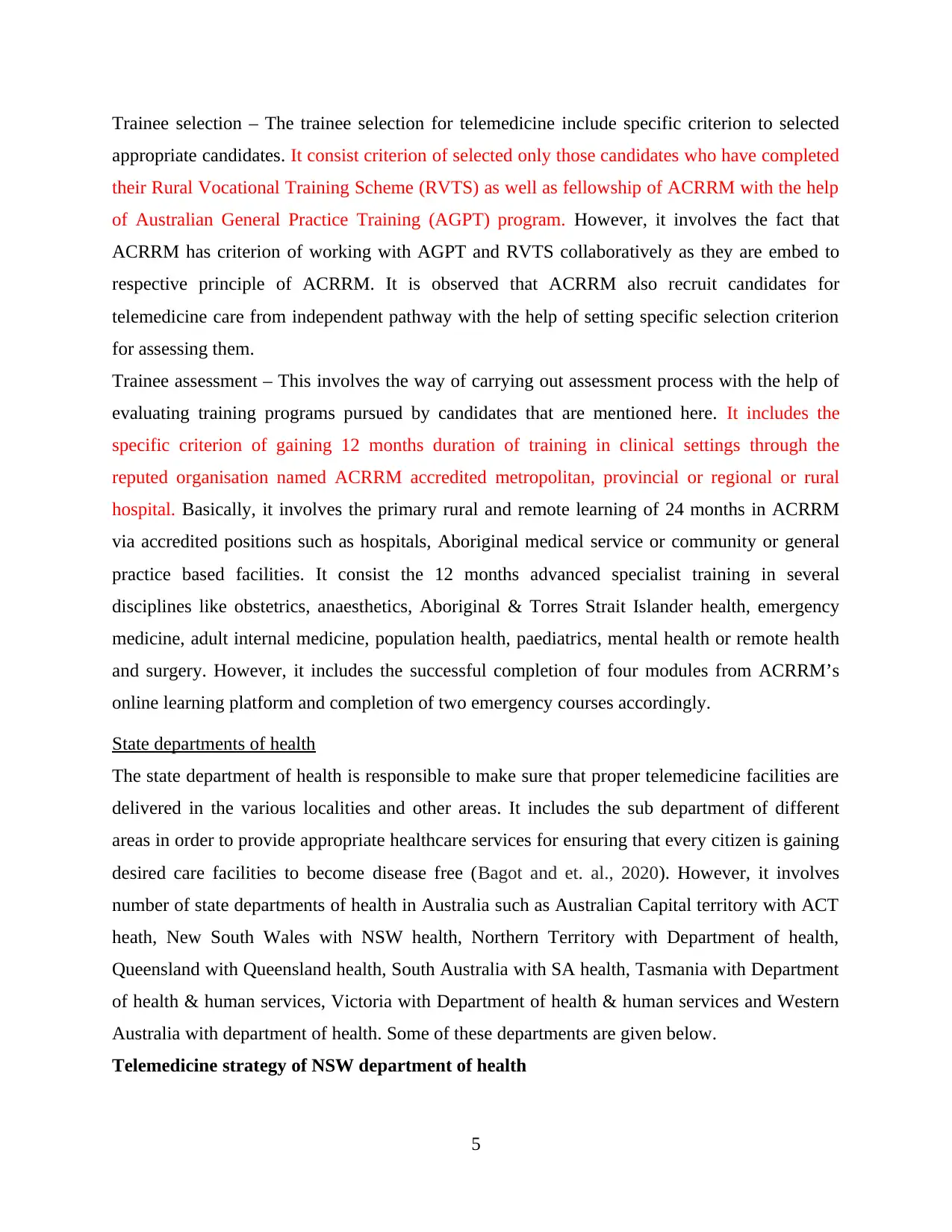
Trainee selection – The trainee selection for telemedicine include specific criterion to selected
appropriate candidates. It consist criterion of selected only those candidates who have completed
their Rural Vocational Training Scheme (RVTS) as well as fellowship of ACRRM with the help
of Australian General Practice Training (AGPT) program. However, it involves the fact that
ACRRM has criterion of working with AGPT and RVTS collaboratively as they are embed to
respective principle of ACRRM. It is observed that ACRRM also recruit candidates for
telemedicine care from independent pathway with the help of setting specific selection criterion
for assessing them.
Trainee assessment – This involves the way of carrying out assessment process with the help of
evaluating training programs pursued by candidates that are mentioned here. It includes the
specific criterion of gaining 12 months duration of training in clinical settings through the
reputed organisation named ACRRM accredited metropolitan, provincial or regional or rural
hospital. Basically, it involves the primary rural and remote learning of 24 months in ACRRM
via accredited positions such as hospitals, Aboriginal medical service or community or general
practice based facilities. It consist the 12 months advanced specialist training in several
disciplines like obstetrics, anaesthetics, Aboriginal & Torres Strait Islander health, emergency
medicine, adult internal medicine, population health, paediatrics, mental health or remote health
and surgery. However, it includes the successful completion of four modules from ACRRM’s
online learning platform and completion of two emergency courses accordingly.
State departments of health
The state department of health is responsible to make sure that proper telemedicine facilities are
delivered in the various localities and other areas. It includes the sub department of different
areas in order to provide appropriate healthcare services for ensuring that every citizen is gaining
desired care facilities to become disease free (Bagot and et. al., 2020). However, it involves
number of state departments of health in Australia such as Australian Capital territory with ACT
heath, New South Wales with NSW health, Northern Territory with Department of health,
Queensland with Queensland health, South Australia with SA health, Tasmania with Department
of health & human services, Victoria with Department of health & human services and Western
Australia with department of health. Some of these departments are given below.
Telemedicine strategy of NSW department of health
5
appropriate candidates. It consist criterion of selected only those candidates who have completed
their Rural Vocational Training Scheme (RVTS) as well as fellowship of ACRRM with the help
of Australian General Practice Training (AGPT) program. However, it involves the fact that
ACRRM has criterion of working with AGPT and RVTS collaboratively as they are embed to
respective principle of ACRRM. It is observed that ACRRM also recruit candidates for
telemedicine care from independent pathway with the help of setting specific selection criterion
for assessing them.
Trainee assessment – This involves the way of carrying out assessment process with the help of
evaluating training programs pursued by candidates that are mentioned here. It includes the
specific criterion of gaining 12 months duration of training in clinical settings through the
reputed organisation named ACRRM accredited metropolitan, provincial or regional or rural
hospital. Basically, it involves the primary rural and remote learning of 24 months in ACRRM
via accredited positions such as hospitals, Aboriginal medical service or community or general
practice based facilities. It consist the 12 months advanced specialist training in several
disciplines like obstetrics, anaesthetics, Aboriginal & Torres Strait Islander health, emergency
medicine, adult internal medicine, population health, paediatrics, mental health or remote health
and surgery. However, it includes the successful completion of four modules from ACRRM’s
online learning platform and completion of two emergency courses accordingly.
State departments of health
The state department of health is responsible to make sure that proper telemedicine facilities are
delivered in the various localities and other areas. It includes the sub department of different
areas in order to provide appropriate healthcare services for ensuring that every citizen is gaining
desired care facilities to become disease free (Bagot and et. al., 2020). However, it involves
number of state departments of health in Australia such as Australian Capital territory with ACT
heath, New South Wales with NSW health, Northern Territory with Department of health,
Queensland with Queensland health, South Australia with SA health, Tasmania with Department
of health & human services, Victoria with Department of health & human services and Western
Australia with department of health. Some of these departments are given below.
Telemedicine strategy of NSW department of health
5
Paraphrase This Document
Need a fresh take? Get an instant paraphrase of this document with our AI Paraphraser
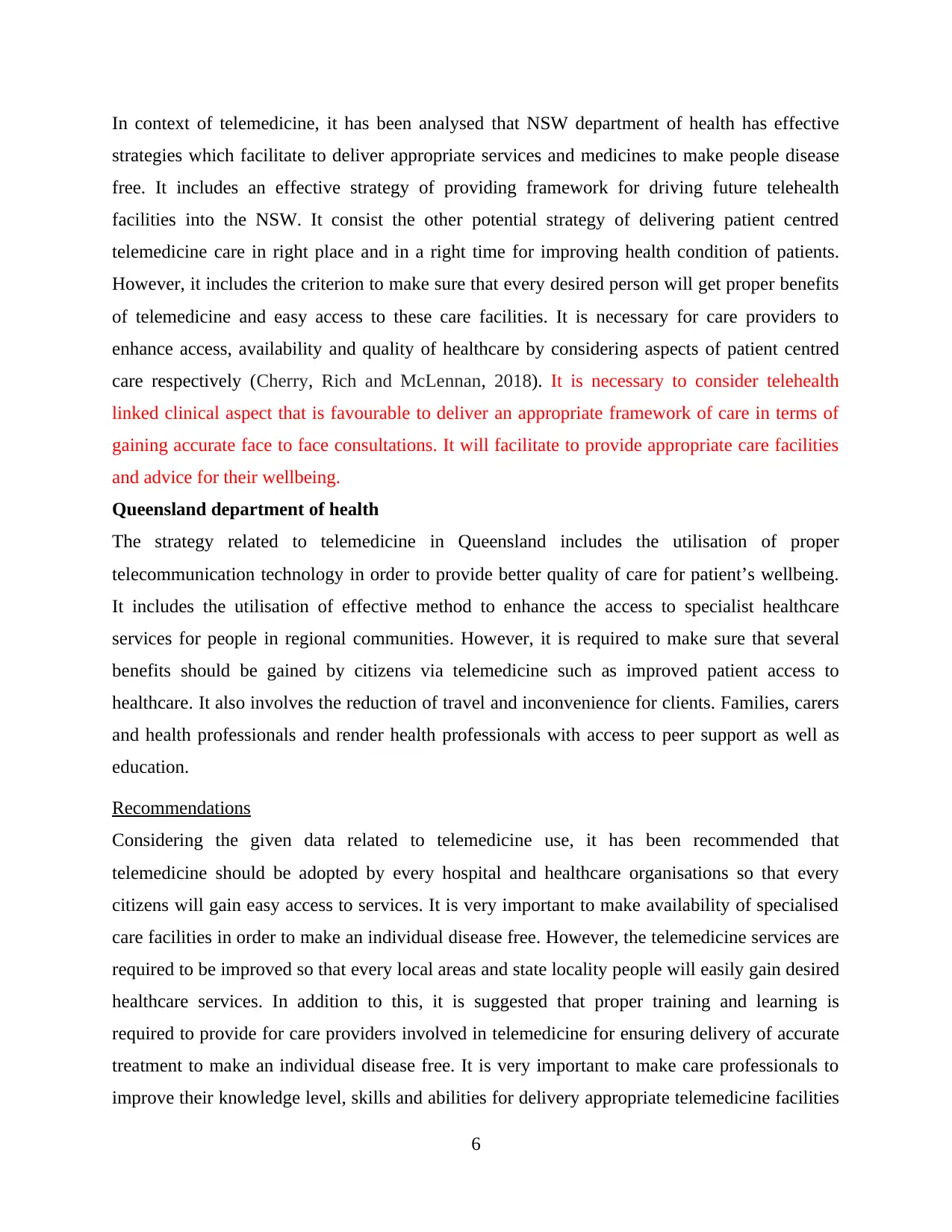
In context of telemedicine, it has been analysed that NSW department of health has effective
strategies which facilitate to deliver appropriate services and medicines to make people disease
free. It includes an effective strategy of providing framework for driving future telehealth
facilities into the NSW. It consist the other potential strategy of delivering patient centred
telemedicine care in right place and in a right time for improving health condition of patients.
However, it includes the criterion to make sure that every desired person will get proper benefits
of telemedicine and easy access to these care facilities. It is necessary for care providers to
enhance access, availability and quality of healthcare by considering aspects of patient centred
care respectively (Cherry, Rich and McLennan, 2018). It is necessary to consider telehealth
linked clinical aspect that is favourable to deliver an appropriate framework of care in terms of
gaining accurate face to face consultations. It will facilitate to provide appropriate care facilities
and advice for their wellbeing.
Queensland department of health
The strategy related to telemedicine in Queensland includes the utilisation of proper
telecommunication technology in order to provide better quality of care for patient’s wellbeing.
It includes the utilisation of effective method to enhance the access to specialist healthcare
services for people in regional communities. However, it is required to make sure that several
benefits should be gained by citizens via telemedicine such as improved patient access to
healthcare. It also involves the reduction of travel and inconvenience for clients. Families, carers
and health professionals and render health professionals with access to peer support as well as
education.
Recommendations
Considering the given data related to telemedicine use, it has been recommended that
telemedicine should be adopted by every hospital and healthcare organisations so that every
citizens will gain easy access to services. It is very important to make availability of specialised
care facilities in order to make an individual disease free. However, the telemedicine services are
required to be improved so that every local areas and state locality people will easily gain desired
healthcare services. In addition to this, it is suggested that proper training and learning is
required to provide for care providers involved in telemedicine for ensuring delivery of accurate
treatment to make an individual disease free. It is very important to make care professionals to
improve their knowledge level, skills and abilities for delivery appropriate telemedicine facilities
6
strategies which facilitate to deliver appropriate services and medicines to make people disease
free. It includes an effective strategy of providing framework for driving future telehealth
facilities into the NSW. It consist the other potential strategy of delivering patient centred
telemedicine care in right place and in a right time for improving health condition of patients.
However, it includes the criterion to make sure that every desired person will get proper benefits
of telemedicine and easy access to these care facilities. It is necessary for care providers to
enhance access, availability and quality of healthcare by considering aspects of patient centred
care respectively (Cherry, Rich and McLennan, 2018). It is necessary to consider telehealth
linked clinical aspect that is favourable to deliver an appropriate framework of care in terms of
gaining accurate face to face consultations. It will facilitate to provide appropriate care facilities
and advice for their wellbeing.
Queensland department of health
The strategy related to telemedicine in Queensland includes the utilisation of proper
telecommunication technology in order to provide better quality of care for patient’s wellbeing.
It includes the utilisation of effective method to enhance the access to specialist healthcare
services for people in regional communities. However, it is required to make sure that several
benefits should be gained by citizens via telemedicine such as improved patient access to
healthcare. It also involves the reduction of travel and inconvenience for clients. Families, carers
and health professionals and render health professionals with access to peer support as well as
education.
Recommendations
Considering the given data related to telemedicine use, it has been recommended that
telemedicine should be adopted by every hospital and healthcare organisations so that every
citizens will gain easy access to services. It is very important to make availability of specialised
care facilities in order to make an individual disease free. However, the telemedicine services are
required to be improved so that every local areas and state locality people will easily gain desired
healthcare services. In addition to this, it is suggested that proper training and learning is
required to provide for care providers involved in telemedicine for ensuring delivery of accurate
treatment to make an individual disease free. It is very important to make care professionals to
improve their knowledge level, skills and abilities for delivery appropriate telemedicine facilities
6
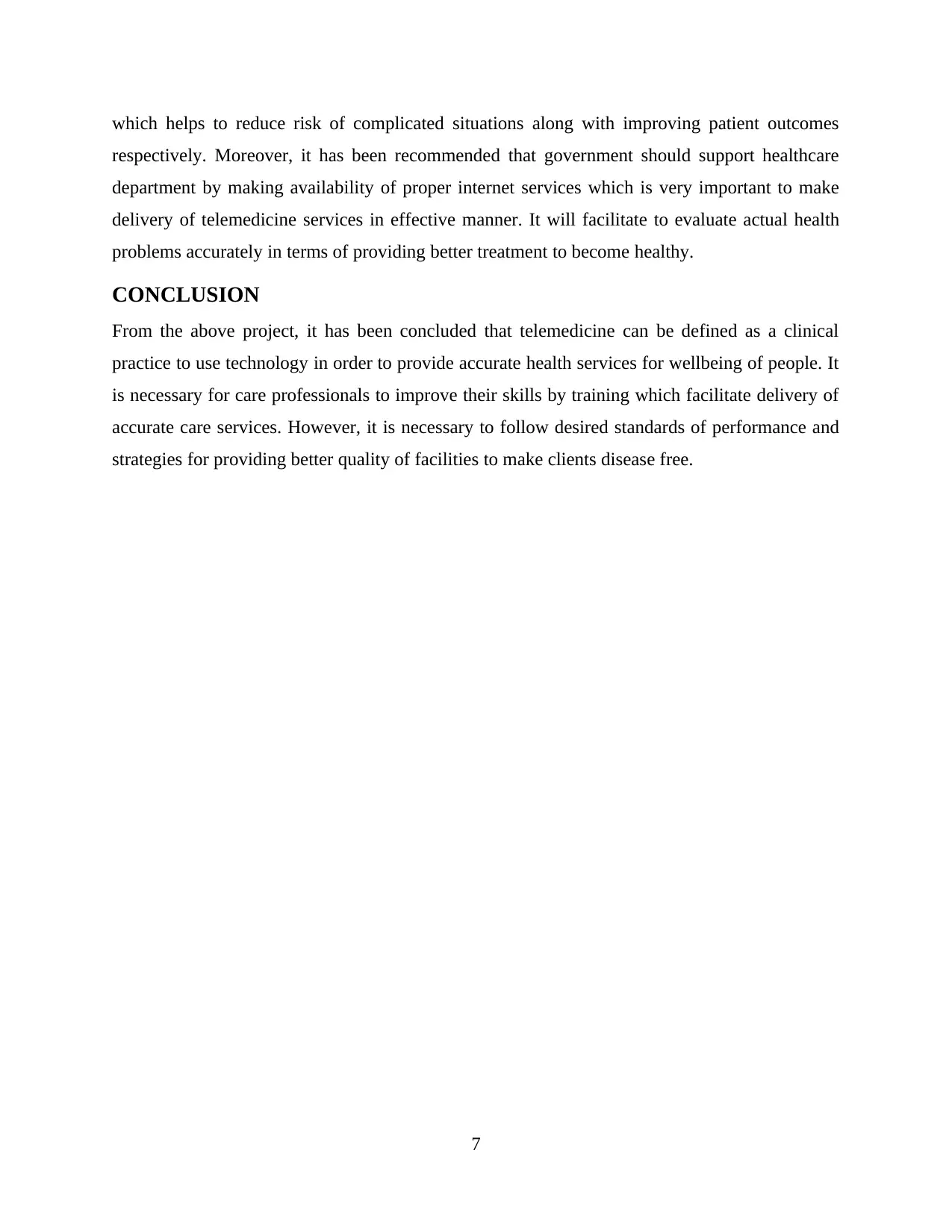
which helps to reduce risk of complicated situations along with improving patient outcomes
respectively. Moreover, it has been recommended that government should support healthcare
department by making availability of proper internet services which is very important to make
delivery of telemedicine services in effective manner. It will facilitate to evaluate actual health
problems accurately in terms of providing better treatment to become healthy.
CONCLUSION
From the above project, it has been concluded that telemedicine can be defined as a clinical
practice to use technology in order to provide accurate health services for wellbeing of people. It
is necessary for care professionals to improve their skills by training which facilitate delivery of
accurate care services. However, it is necessary to follow desired standards of performance and
strategies for providing better quality of facilities to make clients disease free.
7
respectively. Moreover, it has been recommended that government should support healthcare
department by making availability of proper internet services which is very important to make
delivery of telemedicine services in effective manner. It will facilitate to evaluate actual health
problems accurately in terms of providing better treatment to become healthy.
CONCLUSION
From the above project, it has been concluded that telemedicine can be defined as a clinical
practice to use technology in order to provide accurate health services for wellbeing of people. It
is necessary for care professionals to improve their skills by training which facilitate delivery of
accurate care services. However, it is necessary to follow desired standards of performance and
strategies for providing better quality of facilities to make clients disease free.
7
⊘ This is a preview!⊘
Do you want full access?
Subscribe today to unlock all pages.

Trusted by 1+ million students worldwide
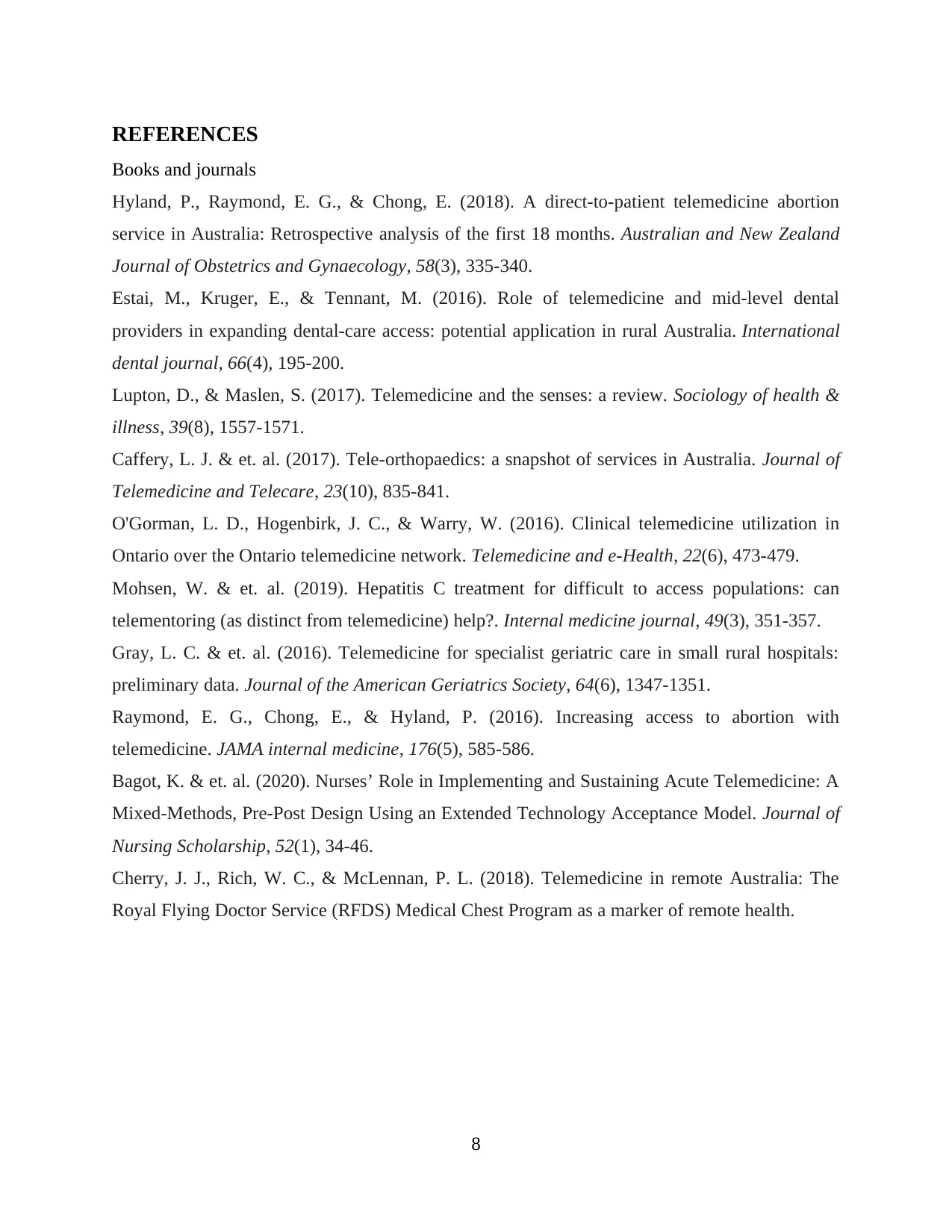
REFERENCES
Books and journals
Hyland, P., Raymond, E. G., & Chong, E. (2018). A direct‐to‐patient telemedicine abortion
service in Australia: Retrospective analysis of the first 18 months. Australian and New Zealand
Journal of Obstetrics and Gynaecology, 58(3), 335-340.
Estai, M., Kruger, E., & Tennant, M. (2016). Role of telemedicine and mid‐level dental
providers in expanding dental‐care access: potential application in rural Australia. International
dental journal, 66(4), 195-200.
Lupton, D., & Maslen, S. (2017). Telemedicine and the senses: a review. Sociology of health &
illness, 39(8), 1557-1571.
Caffery, L. J. & et. al. (2017). Tele-orthopaedics: a snapshot of services in Australia. Journal of
Telemedicine and Telecare, 23(10), 835-841.
O'Gorman, L. D., Hogenbirk, J. C., & Warry, W. (2016). Clinical telemedicine utilization in
Ontario over the Ontario telemedicine network. Telemedicine and e-Health, 22(6), 473-479.
Mohsen, W. & et. al. (2019). Hepatitis C treatment for difficult to access populations: can
telementoring (as distinct from telemedicine) help?. Internal medicine journal, 49(3), 351-357.
Gray, L. C. & et. al. (2016). Telemedicine for specialist geriatric care in small rural hospitals:
preliminary data. Journal of the American Geriatrics Society, 64(6), 1347-1351.
Raymond, E. G., Chong, E., & Hyland, P. (2016). Increasing access to abortion with
telemedicine. JAMA internal medicine, 176(5), 585-586.
Bagot, K. & et. al. (2020). Nurses’ Role in Implementing and Sustaining Acute Telemedicine: A
Mixed‐Methods, Pre‐Post Design Using an Extended Technology Acceptance Model. Journal of
Nursing Scholarship, 52(1), 34-46.
Cherry, J. J., Rich, W. C., & McLennan, P. L. (2018). Telemedicine in remote Australia: The
Royal Flying Doctor Service (RFDS) Medical Chest Program as a marker of remote health.
8
Books and journals
Hyland, P., Raymond, E. G., & Chong, E. (2018). A direct‐to‐patient telemedicine abortion
service in Australia: Retrospective analysis of the first 18 months. Australian and New Zealand
Journal of Obstetrics and Gynaecology, 58(3), 335-340.
Estai, M., Kruger, E., & Tennant, M. (2016). Role of telemedicine and mid‐level dental
providers in expanding dental‐care access: potential application in rural Australia. International
dental journal, 66(4), 195-200.
Lupton, D., & Maslen, S. (2017). Telemedicine and the senses: a review. Sociology of health &
illness, 39(8), 1557-1571.
Caffery, L. J. & et. al. (2017). Tele-orthopaedics: a snapshot of services in Australia. Journal of
Telemedicine and Telecare, 23(10), 835-841.
O'Gorman, L. D., Hogenbirk, J. C., & Warry, W. (2016). Clinical telemedicine utilization in
Ontario over the Ontario telemedicine network. Telemedicine and e-Health, 22(6), 473-479.
Mohsen, W. & et. al. (2019). Hepatitis C treatment for difficult to access populations: can
telementoring (as distinct from telemedicine) help?. Internal medicine journal, 49(3), 351-357.
Gray, L. C. & et. al. (2016). Telemedicine for specialist geriatric care in small rural hospitals:
preliminary data. Journal of the American Geriatrics Society, 64(6), 1347-1351.
Raymond, E. G., Chong, E., & Hyland, P. (2016). Increasing access to abortion with
telemedicine. JAMA internal medicine, 176(5), 585-586.
Bagot, K. & et. al. (2020). Nurses’ Role in Implementing and Sustaining Acute Telemedicine: A
Mixed‐Methods, Pre‐Post Design Using an Extended Technology Acceptance Model. Journal of
Nursing Scholarship, 52(1), 34-46.
Cherry, J. J., Rich, W. C., & McLennan, P. L. (2018). Telemedicine in remote Australia: The
Royal Flying Doctor Service (RFDS) Medical Chest Program as a marker of remote health.
8
1 out of 10
Related Documents
Your All-in-One AI-Powered Toolkit for Academic Success.
+13062052269
info@desklib.com
Available 24*7 on WhatsApp / Email
![[object Object]](/_next/static/media/star-bottom.7253800d.svg)
Unlock your academic potential
Copyright © 2020–2025 A2Z Services. All Rights Reserved. Developed and managed by ZUCOL.





